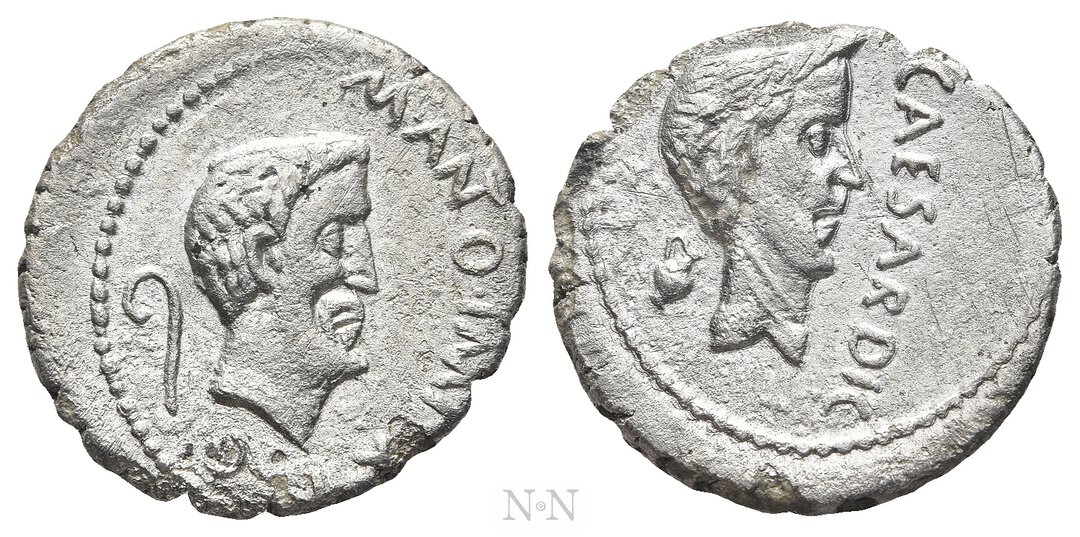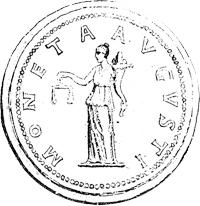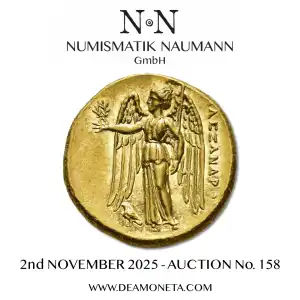



MARK ANTONY, with JULIUS CAESAR. Denarius (43 BC). Military mint traveling with Antony in Cisalpine Gaul. Posthumous Caesar issue.
Obv: M ANTO IMP R P C.
Bare head of Antony right; lituus to left.
Rev: CAESAR DIC.
Head of Caesar right; capis to left.
Crawford 488/2; CRI 123; RBW -.
Following the assassination of Julius Caesar (44 BC), the city celebrated the feat of the conspirators who had ended the dictator's life. Mark Antony, by reading the deceased's will and delivering an eloquent speech, managed to win to his side the Roman people, forcing the Caesaricides to leave Rome, but allowing Brutus to move to Mantua where he gained control of Gallia Comata. The political scene changed when Octavian, Caesar's great-nephew, came to power. Using his family name and wanting to get revenge for his dad, he got a lot of support in the Senate and pushed for tougher measures against Caesar's killers. Antony then moved against Brutus and started the siege of Modena, but he lost more and more support in the Senate, partly because of Cicero's Philippics, and was declared a “public enemy.” This led to a confrontation between the armies of Antony and Octavian at Modena, where the two consuls, Hirtius and Pansa, lost their lives. Octavian won the battle but eventually made peace with Antony. This agreement led to the creation of the Second Triumvirate (43 BC) together with the Magister Equitum, Marcus Lepidus. Unlike the First Triumvirate, the Second was a genuine political office lasting five years and approved by law. The triumvirs drew up a list of citizens believed to be Caesar's killers or their accomplices and brutally restored order in Rome. This denarius, which also bears Caesar's portrait, is intended to remind the people of Antony's role alongside the beloved dictator and his commitment to avenging his assassination.
Condition: Good very fine; edge faults.
Weight: 3.54 g.
Diameter: 19 mm.
Obv: M ANTO IMP R P C.
Bare head of Antony right; lituus to left.
Rev: CAESAR DIC.
Head of Caesar right; capis to left.
Crawford 488/2; CRI 123; RBW -.
Following the assassination of Julius Caesar (44 BC), the city celebrated the feat of the conspirators who had ended the dictator's life. Mark Antony, by reading the deceased's will and delivering an eloquent speech, managed to win to his side the Roman people, forcing the Caesaricides to leave Rome, but allowing Brutus to move to Mantua where he gained control of Gallia Comata. The political scene changed when Octavian, Caesar's great-nephew, came to power. Using his family name and wanting to get revenge for his dad, he got a lot of support in the Senate and pushed for tougher measures against Caesar's killers. Antony then moved against Brutus and started the siege of Modena, but he lost more and more support in the Senate, partly because of Cicero's Philippics, and was declared a “public enemy.” This led to a confrontation between the armies of Antony and Octavian at Modena, where the two consuls, Hirtius and Pansa, lost their lives. Octavian won the battle but eventually made peace with Antony. This agreement led to the creation of the Second Triumvirate (43 BC) together with the Magister Equitum, Marcus Lepidus. Unlike the First Triumvirate, the Second was a genuine political office lasting five years and approved by law. The triumvirs drew up a list of citizens believed to be Caesar's killers or their accomplices and brutally restored order in Rome. This denarius, which also bears Caesar's portrait, is intended to remind the people of Antony's role alongside the beloved dictator and his commitment to avenging his assassination.
Condition: Good very fine; edge faults.
Weight: 3.54 g.
Diameter: 19 mm.


